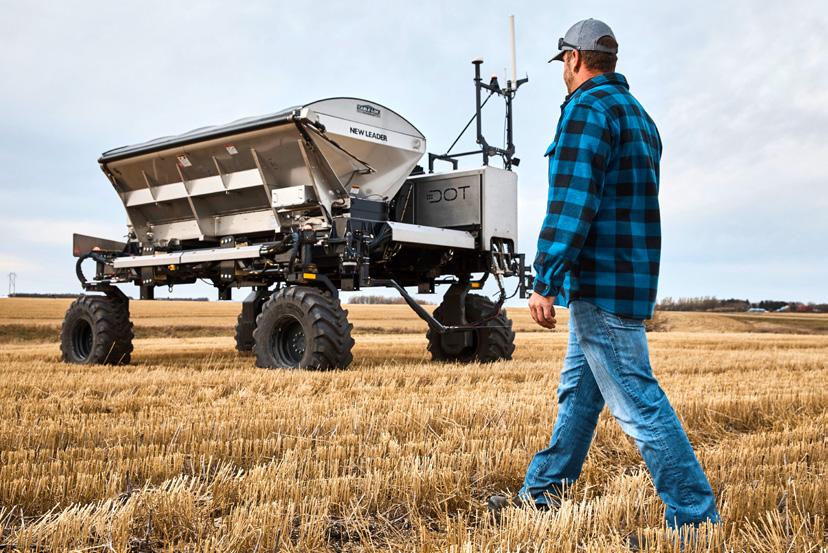
4 minute read
Paving the Future of Precision Agriculture
By Sadie Vander Wal
Lying in the heart of the Midwestern prairies, South Dakota State University has been making an impact in research, education and outreach through its land grant mission since 1881. With deep roots in agriculture, SDSU’s College of Agriculture, Food and Environmental Sciences is no stranger to generating innovative solutions to meet the demands of our growing world. In fact, a potential solution to that demand came to life right at SDSU in the form of the nation’s first four-year degree in precision agriculture.
Advertisement
Over the past several years, precision technology has revolutionized the way we produce food and fiber. As a result, the use of GPS navigation, satellite imagery or drones is no longer uncommon on agricultural production operations. However, as technology has evolved, the need for trained professionals with the knowledge of how to operate and improve such technology has only increased with time.
The solution to this growing demand? A bachelor’s degree in precision agriculture from SDSU.
Recognizing the region’s need for graduates with strong skill sets in the precision agriculture field, SDSU filled the void by creating an academic minor in precision agriculture in 2014. After the minor quickly gained popularity, the college began constructing a curriculum consisting of both agronomic and agricultural engineering courses. From there, the SDSU Department of Agronomy, Horticulture and Plant Science and Department of Agricultural and Biosystems Engineering produced the nation’s first four-year degree in precision agriculture.
“Our precision agriculture students are not only learning about equipment, but also about agronomy, soil science and data analytics before putting all of the pieces together to understand how technologies work and how they can be applied to any given farmer,” South Dakota Corn Endowed Dean of the College of Agriculture, Food
and Environmental Sciences John Killefer said. “We need graduates who understand the broad spectrum of the field of precision agriculture, and we developed this program to fill that need.”
Prior to SDSU’s program, only technical programs offered a degree in precision agriculture. The difference between these two-year programs and SDSU’s bachelor’s program lies in the focus of their curriculums. While many technical programs concentrate on how to use agricultural equipment and technology, SDSU broadens the field through training in several aspects of agronomy, agricultural engineering and other related courses to provide students with the knowledge of how to adapt to the changing needs of the industry and create innovative solutions that will result in a larger profit for the producer.
“Using technologies that capture data can allow farmers to make better management decisions,” Killefer said. “The better we can manage those decisions, the more economically viable and sustainable we become.”
When it comes to soybean production in South Dakota, the science generated in precision technology goes beyond precise seed placement. Harnessing a more stabilized yield across a field can be difficult to achieve in areas with high amounts of variability, which is common in the Midwest. Precision technologies enable producers to stabilize soybean yields across differing parts of the field, increasing the average yield potential and the ability to market more bushels of grain at harvest. While contributing to the production of these technologies, SDSU is also training its students to understand the engineering behind the technology and the specific needs of the soil and its crops.
“Tools are just toys unless you really know how to use them and put them to work,” Agronomy, Horticulture and Plant Science Department Head Dr. David Wright said. “Our program familiarizes students with these technologies to help both the farmer and retailer make a profit.”
Soon, undergraduate students’ learning experiences will be further enhanced at SDSU through the Raven Precision Agriculture Center, a 129,000-square-feet building on the northwest edge of campus that will provide new opportunities for laboratory and classroom capabilities. The cutting-edge facility will allow the university to continue to lead the nation in precision agriculture education, research and extension, bringing agronomy, engineering and computer science disciplines all under one roof.
“Our faculty, students and industry partners can attack the issues facing agriculture together in one space, engaging in rich conversations and getting better results,” Killefer said.
With construction on the Raven Precision Agriculture Center scheduled to conclude in summer 2021, the college will welcome students to the new facility in time for fall 2021 classes.

“I’m really excited about the space we will have,” Agricultural and Biosystems Engineering Department Head Dr. Van Kelley said. “This will be the first time in many generations we will be able to have hands-on laboratory experiences with full-sized equipment every month of the year.”
As the world continues to grow, the agriculture industry quickly adapts its technologies to sustain the future. SDSU strives to work ahead of this fast-paced curve by preparing students to create solutions for any challenge that may arise.










